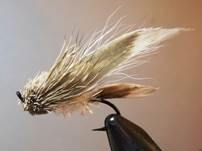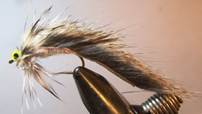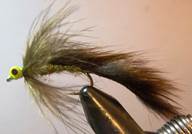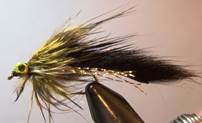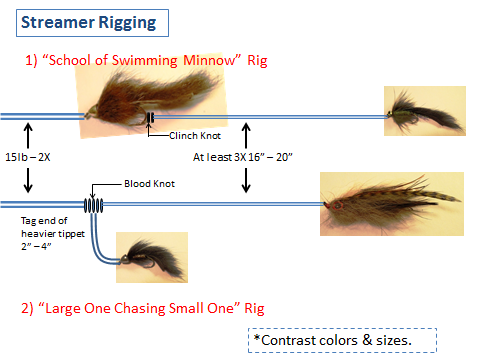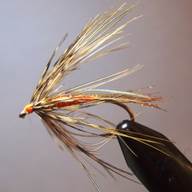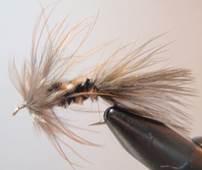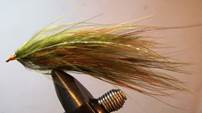LATE & EARLY SEASON FISHING AT DEPUY'S SPRING CREEK (part 8)
| Sysadmin Note |
|---|
| Part 7 can be found here |
STREAMERS & LARGE SOFT-HACKLES
Meat Department:
Next I'd like to discuss tactics and techniques in more details. This chapter covers more details for fishing with streamers and large soft-hackles. Some of visiting anglers never think about using these "meat flies" at DePuy's. Also others who claim to be "dry-fly enthusiasts" will never understand or even try to fish with these large flies. In my opinion, those anglers are limiting their opportunities. Information provided here is not limited to only spawning periods in the fall and spring at DePuy's, rather these can be applied to any month and at any other spring creek.
Understanding Trout Behavior:
Why do trout chase and bite these large objects passing around them? Aggression and curiosity can explain this action among all sizes of trout. Trout become predatory and territorial as they grow larger. They attack threats in order to protect their resting spots (or spawning beds when they are in spawning phases). Then for the most practical reason, all trout want to eat the most with the minimum effort. Sculpins, minnows, baby trout, and leeches (all of these are abundant in most spring creeks) are "prime rib" for trout.
Attitude Adjustments:
So the concept is the same as fishing big rivers such as the Madison and Yellowstone . However some subtlety is required in your attitude. Walk along the bank and wade the creek very carefully. Approach trout just like when you target rising trout with dry-flies. Streamer patterns and techniques need to be adjusted as well. Before discussing successful methods and patterns I would give the following advice. No aggressive wading attitude. This may be permissible on big water but will spook trout before you make your first cast on most spring creeks. Humongous patterns make too much splash, repetitive castings, and super-fast retrieves will spook trout way before they see your offerings. Spending days at DePuy's I have seen several anglers who were fishing with 5-inch streamers, 8 weight rods, and wading aggressively. I stayed away from them before I got snagged or run over.
Spring Creek Streamers:
Patterns lengthening from 1 to 3-inch (hook sizes 12 to 6) are suitable for DePuy's (and for Armstrong's and Nelson's). Favorite colors are natural tan, black, and mottled (mix of olive, brown, black, tan, and so forth). Please check back patterns introduced in PART 4 and 6 also.
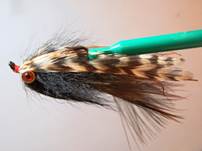 |
|
|
McKnight's Home Invader – Black |
Muddler minnow |
|
Doug McKnight's (www.bigwaterstudio.com) Home Invader in black is also my all-time go-to streamer. Combinations of colors (wings, flash, eyes, and tail) are unlimited. Each one can be "bite of the day". |
This classic is still a staple around here. Shown here is tied in natural appearance with an up-eye salmon hook to add some weight. Smaller ones are ideal to be trailed with large and heavy patterns. |
|
|
|
|
Yamamoto's ZAC Fry – Natural |
– Mottled Olive & Brown |
– Mottled Black & Olive |
Hook: Dai-Riki 280 size 8 to 12
|
||
(*ZAC = Zonked And Chomped!!) Large predatory trout seem to find these small Zonker types just suitable for "one quick bite". Shown are three of my basic arsenals in my box. I experiment combinations of colors at my bench then at the creek. It can be fished by itself or trailed with larger ones. It also can be fished dead-drifting under indicator.
|
||
Rigging:
6 weight 9-foot rod with a floating line is just fine. Leader is 9 to 10 foot ending with 2x tippet (with this set up one can change into a nymph or soft-hackle rig quickly). To target several deep pools and runs at DePuy's I even use an intermediate (1.5-2.0 ips) or full (5.0-6.0 ips) sinking lines with a short (4 to 6-foot) and heavy leader. Some may wonder if I'm no different from those questionable (hazardous) anglers mentioned above, but I follow the rule of subtlety at spring creeks. So I'm using my "river gear" with a "spring creek attitude". I have tested my rigging and proven its necessity and effectiveness. Remember that I can get away with 4x and 5x tippets during midge and BWO hatches. That's because I master and adjust "angles of presentations". The same idea can be applied here. By mastering subtlety and stealthy, a 15 pound test tippet under water with streamers doesn't bother the trout at all. Furthermore, this may startle some readers even more, but I typically tandem-rig two streamers. My guidelines for combining two are 1) different sizes (one is larger than the other) and 2) different colors (one dark and the other light). I tie them on as depicted below.
|
Methods: 1:
Dead-drift or swing streamers in riffles with long (about a foot) and slow retrieves (adjust speed so they don't snag the bottom).
2: Cast and sink streamers into deep holes and runs and retrieve with long and slow or sometimes Figure-8 method.
3: At deep spots, mend floating line so streamers go deep as quickly as possible. Sometimes I even apply split-shots.
4: When you locate trout at shallow spots, aim streamers several feet above them. Then by mending, slow down and bounce streamers deliberately toward trout's faces.
Where to Look:
Apparent deep spots are obvious places, but also never ignore riffles, cutbanks, and many other structures. I often have opportunities for sight-fishing with streamers. It's truly "eye-to-eye" experience. I have only one shot. It will be either bite or spook.
Large Soft-Hackles:
At DePuy's, large soft-hackles essentially serve like streamers; minnow, sculpins, and such. But also, large soft-hackles are more undulating than most streamers, which definitely presents a different silhouette and perhaps taste to trout. Especially during spawning time this undulating effect combined with fly manipulations causes tremendous irritation and instinctive aggression among large territorial trout. On several occasions I have seen trout chased my soft-hackles for more than several feet and tried to crush them!! Sight is amazing, even terrifying!!
Patterns: Unlike the streamers mentioned above, I don't really sort large soft-hackles into boxes for rivers or for creeks. Patterns I use for fall-runners in Madison within Yellowstone Park have been successfully catching trout at DePuy's as well. Vise versa. That explains versatility of soft-hackles.
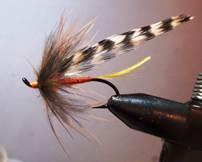 |
|
|
Yamamoto's COYOTE Version 3 (Spruce Coyote) |
Yamamoto's Mr. O-O |
Yamamoto's Brindle Sparrow |
Version 3 was born simultaneously with Version 2. It's an evolution of Spruce streamers!! Strip, swing, bounce, or twitch it! Not only in spring creeks, try at big rivers like Yellowstone and Madison! |
This is the new generation of large soft-hackles. From the first trial, it became the best and deadliest weapon of mine!! It can be used even as a nymph under an indicator. I believe the bead helps charging the depth, then extra-long & colorful hackle fibers cause further irritation among trout. |
A slight modification of Sparrow. By changing chenille colors, one can present any kinds of organisms. Fish up-stream under an indicator as a nymph, then fish back down-stream by swinging (vise- versa). Either way it can't fail to catch fish!! |
|
|
|
Gartside's Soft Hackle Streamer |
Multi Color Soft Hackle Streamer – Master Angler Version |
|
This simple and classic pattern still holds a spot or two in my box. It's simply irresistible for trout. |
Learned from Tom Travis, this one adds more colors, movements, and bulk on the original. It must look tasty for trout but in my observation, trout seem to bite this from irritation and aggression when it's passing in front of them. |
|
Rigging:
5 or 6 weight 9-foot rod with floating line will do. Leader-tippet is 9- to 10-foot long ending 3x or even 2x. I rig up two flies all the time. My guidelines of combining two are: 1: contrast sizes (one large and the other small) and 2: contrast colors (one bright and the other dark). I tie them on my tippet as the drawing.
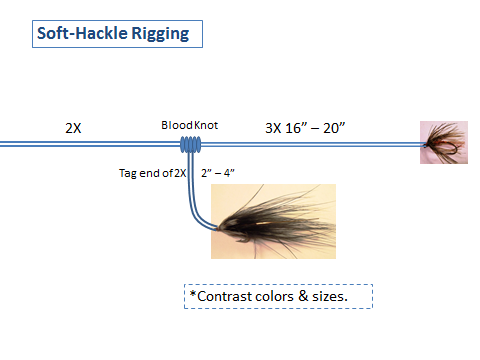 |
Methods:
With large soft-hackles I don't target obvious deep runs and pools. Rather I look for riffles with moderate current and gravel bottoms (potential spawning beds/resting spots) and chutes (= "fish paths"). Methods I employ are:
1: Cast and swing down-&-cross, mending in order to slow down,
2: Add twitch and strips during swing, and
3: When trout are located at shallow spots, aim soft-hackles several feet above them. Then by mending, slow down and bounce them deliberately toward the trout's face.
Your Options:
Fishing with streamers and large soft-hackles can be only options to fish at DePuy's when SW winds blow so hard. Strong SW winds usually blow away insects on the surface, turn down rising trout, and make casting (dry-flies and nymphs) and line-controlling very difficult. In that case, rather than struggling against the winds, casting streamers and soft-hackles down and across is easier. This method usually saves the day at very end. Also as often quoted, overcast days (cloudy & rainy) produce surprising results. One of them can be truly a trophy which seldom comes up on dry-flies. Even when dry-fly fishing is expected, one should try streamers and soft-hackles before and after insect hatches.
If some anglers still refuse to fish like this or to adjust attitudes/methods, that's fine with me. Information here is one of the examples of "adaptability and open-mindedness" at spring creeks. We have to understand trout and then adjust our methods and approaches according to what the trout do. After all, we all want to catch trout, don't we?
Satoshi Yamamoto, http://leftyangler.blogspot.com, brought his passion for fly-fishing & fly-tying from Japan to Montana and became the first ever Japanese guide in Livingston, MT. He guides and fishes big rivers like Madison & Yellowstone, spring creeks in Paradise Valley, and various waters in Yellowstone Park. Hence, with his Regal Vise at the bench, his fly tying interests vary from tiny midges to 5-inch streamers and anything in between. Once his ideas are combined he goes out for experiments at those near-by waters. Satoshi submits his innovative patterns to Montana Fly Company (www.montanafly.com).
His own innovative original patterns can be purchased from his fly-shop, http://leftytyer.blogspot.com.
| Sysadmin Note |
|---|
| Part 9 can be found here |

